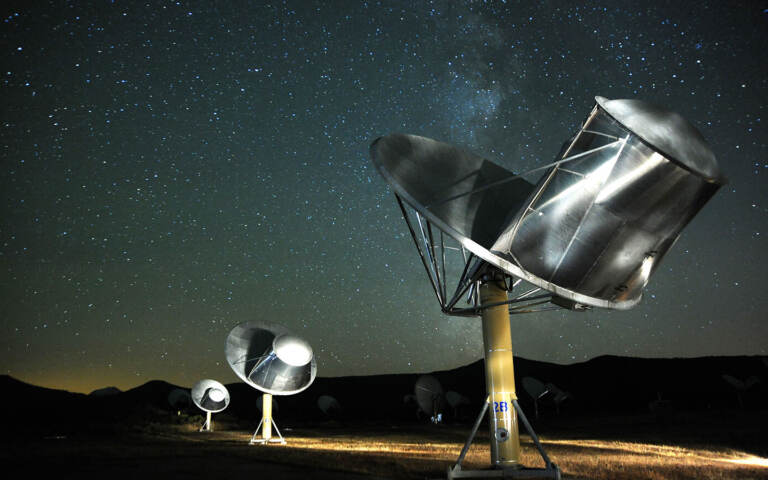‘All or nothing’: Scientists search for extraterrestrial intelligence
Humans have long asked the question, “Are we alone?” These SETI scientists are on a quest to find out
Listen 9:47
The Allen Telescope Array at SETI Institute. (Seth Shostak/SETI Institute)
This story is from The Pulse, a weekly health and science podcast.
Find it on Apple Podcasts, Spotify, or wherever you get your podcasts.
When your day job is looking for signs of alien life, you’ve got to get used to people’s incredulous reactions, or what astrophysicist Adam Frank calls “the giggle factor.”
Frank teaches at the University of Rochester in New York. He discovered astronomy through a love of science fiction as a kid. The fact that some people don’t take his work seriously hasn’t deterred him from striving for answers.
“There are two questions everybody wants to know,” he said. “One is what happens when you die, and the other is, are we the only time in cosmic history that life has formed?”
The scientists working to answer this big question are prepared for a long road. Many have been chipping away at it for decades — like Jill Tarter.
“You just have to understand the search space, the volume that we might have to explore is just vast,” she said. “This might be an intergenerational project. It might be my great-granddaughter who finally succeeds.”
Tarter helped found the SETI Institute in Mountainview, California, in the 1980s, a non-profit research institute dedicated to the search for extraterrestrial intelligence.
“It isn’t a differential process, right? So we won’t do a little today, and then tomorrow we’ll do a little more, and then we’ll be a little closer to knowing that there’s life beyond Earth,” Tarter said. “It’s either an all or a nothing. And what changes is the amount of searching you can do for different types of manifestations.”
All or nothing. Despite the daunting task, the researchers I spoke with maintained a sense of humor about their work. When I first spoke to Dan Werthimer at the Berkeley SETI Institute, he issued a playful warning: “Be careful what you say, Sarah, when you’re on the radio, because this stuff just goes out into space, and you can’t recall it.”
Subscribe to The Pulse
This is one of the main ideas of the search for extraterrestrial intelligence — here on Earth, we emit lots of television, radar, and radio signals out into space.
“If E.T.’s out there, maybe they have technology similar to ours,” Werthimer said. “Maybe they have radio, radar or television or something that we could detect. Maybe they’d even send us a deliberate signal.”
When Werthimer says “E.T.,” he’s not talking about the cute little alien from the movie — he means real extraterrestrials.
Werthimer and his colleagues in the field are looking for what are called technosignatures, which are any sign of technology in the universe that may have been emitted by other civilizations, like radio or TV signals, lasers, or infrared radiation.
“The idea is that they have some technological artifact that leaks off their planet, like radio or television or radar navigational beacons or something like that. Some people are looking for civilizations that use a lot of energy,” Werthimer said.
“Maybe they build a big shell around their star that soaks up all the starlight. So they have a lot of energy, and that energy would radiate away as waste heat when they use that energy. And so if you look for a star that has a lot of extra heat or infrared radiation, that’s another way to look for very advanced civilizations.”
Technosignatures are one potential sign of life scientists are looking for, while the others are called biosignatures. A biosignature can be anything — a molecule, a particle, an element — that indicates the presence of some kind of life, even on a primitive level.
NASA has funded the search for biosignatures and primitive forms of life, like sending rovers to Mars to look for fossil microbes. Those programs have cost billions of dollars, and the updates make international news.
Meanwhile, the search for intelligent life has struggled to retain steady funding — and to be taken seriously.
This has been a bit of a thorn in the side of researchers like Adam Frank, the astrophysicist from the University of Rochester.
“NASA has been funding the search for unintelligent life for a very long time, for at least 20 years,” he said. “You know, why are you searching for dumb life, but you’re going to be like, ‘no, no, no, no, don’t mention smart life to us.’”
But in 2020, Frank and a group of scientists did get a grant from NASA to look for technosignatures. And according to Frank, that’s a sea change. Because in terms of searching for signs of life in the universe, we’ve barely scratched the surface.
“If the sky is an ocean, and you’re looking for fish in the ocean, so far what we’ve done is we’ve pulled up a hot tub worth of water and looked for fish in it,” Frank said.
That said, scientists now have a better idea of where in this vast ocean they should look, because of what Frank calls the “exoplanet revolution” in 1995, when scientists discovered other planets that orbit a main star.
“Discovering planets, discovering planets in the habitable zone, that changed everything,” he said. “We’re no longer just casting around in the dark. We know exactly where to look, and we know exactly how to look.”
The “habitable zone” Frank is referring to is also known as the Goldilocks zone. It’s the distance from a star where liquid water could exist on its orbiting planets — not too hot, and not too cold.
So, if we know life is most likely to exist on exoplanets in the habitable zone, researchers have a roadmap of where to look.
That’s a far cry from where the modern search for extraterrestrial intelligence began, with Frank Drake’s Project Ozma at the Greenbank Observatory in West Virginia in 1960.
“He tuned the big radio telescopes to frequencies he thought might be good for communication and pointed [them] at the nearest stars to see if he could find anything,” said Jason Wright, an astrophysicist at Penn State University.
Wright runs the Extraterrestrial Intelligence Center there, one of a handful of academic programs in the country devoted to looking for extraterrestrial life. It was founded in 2020 to be the academic home of the search.
The founding of an academic center might not sound like much, but for SETI research, it was a big deal. One of the center’s goals is to formalize SETI research in an academic setting — to create a robust body of scholarly work, and scholars themselves.
“It’s not just people looking,” Wright said. “It’s people learning to look, training to look, thinking of new ways to look, developing new ways to look, and expanding the pool of people who can work on the field.”
There’s still a way to go to get the search for technosignatures to be treated on the same footing as biosignatures. But there are a few big projects leading the way: Breakthrough Listen, a privately funded project that buys time on existing telescopes to conduct SETI research surveys the million closest stars to Earth.
PANOSETI at the University of San Diego is looking for visual technosignatures, like lasers or infrared signals. When it’s fully constructed, PANOSETI will be a collection of telescopes pointing in different directions across the sky, with the ability to detect pulsed signals down to the nanosecond.
Despite the progress SETI has made, I had to wonder: Even if we look for extraterrestrial life in all the ways we know how, couldn’t it be likely that life could present itself in a way that we can’t fathom or even detect?
Not exactly, said Adam Frank.
“As I always like to say, aliens are not magic,” he said with a laugh. “I mean, they’re going to be based in molecules and they’re going to use light. I mean, how can they not? Wherever life started, it has to start the same way our stuff started.”
That’s not to say Frank thinks extraterrestrial life will look exactly like us.
“I expect to be surprised,” he said. “I think that most of the time, life is going to be forced to choose pathways like it chose here.”
Humans have pondered the existence of life outside our planet for just about as long as we’ve been on Earth. And Dan Werthimer from Berkeley said we just might be closer to finding what’s out there.
“This question, ‘are we alone?’ has been the question I think humans have been asking for hundreds of thousands of years. You look up at the stars at night and you can’t help asking that question,” said Werthimer. “And our generation … maybe has the right science and technology where we might be able to answer the question. It calibrates our place in the universe.”
WHYY is your source for fact-based, in-depth journalism and information. As a nonprofit organization, we rely on financial support from readers like you. Please give today.






